Anwar Sadat
Muhammad Anwar el-Sadat[lower-alpha 1] (25 December 1918 – 6 October 1981) was an Egyptian politician and military officer who served as the third president of Egypt, from 15 October 1970 until his assassination by fundamentalist army officers on 6 October 1981. Sadat was a senior member of the Free Officers who overthrew King Farouk in the Egyptian Revolution of 1952, and a close confidant of President Gamal Abdel Nasser, under whom he served as Vice President twice and whom he succeeded as president in 1970. In 1978, Sadat and Menachem Begin, Prime Minister of Israel, signed a peace treaty in cooperation with United States President Jimmy Carter, for which they were recognized with the Nobel Peace Prize.
Anwar Sadat | |
|---|---|
| أنور السادات | |
 Sadat in 1980 | |
| 3rd President of Egypt | |
| In office 15 October 1970 – 6 October 1981 Acting: 28 September 1970 – 15 October 1970 | |
| Prime Minister | See list
|
| Vice President | See list
|
| Preceded by | Gamal Abdel Nasser |
| Succeeded by | Sufi Abu Taleb (Acting) |
| 37th Prime Minister of Egypt | |
| In office 15 May 1980 – 6 October 1981 | |
| President | Himself |
| Preceded by | Mustafa Khalil |
| Succeeded by | Hosni Mubarak |
| In office 26 March 1973 – 25 September 1974 | |
| President | Himself |
| Preceded by | Aziz Sedki |
| Succeeded by | Abd El Aziz Muhammad Hegazi |
| Vice President of Egypt | |
| In office 19 December 1969 – 14 October 1970 | |
| President | Gamal Abdel Nasser |
| Preceded by | Hussein el-Shafei |
| Succeeded by | Ali Sabri |
| In office 17 February 1964 – 26 March 1964 | |
| President | Gamal Abdel Nasser |
| Preceded by | Hussein el-Shafei |
| Succeeded by | Zakaria Mohieddin |
| Speaker of the National Assembly of Egypt | |
| In office 21 July 1960 – 20 January 1969 | |
| President | Gamal Abdel Nasser |
| Preceded by | Abdel Latif Boghdadi |
| Succeeded by | Mohamed Labib Skokeir |
| Personal details | |
| Born | Muhammad Anwar el-Sadat محمد أنور السادات 25 December 1918 Monufia, Sultanate of Egypt |
| Died | 6 October 1981 (aged 62) Cairo, Egypt |
| Manner of death | Assassination |
| Resting place | Unknown Soldier Memorial |
| Political party | National Democratic Party |
| Other political affiliations | Arab Socialist Union |
| Spouses |
|
| Children | 7 |
| Alma mater | University of Alexandria |
| Signature |  |
| Military service | |
| Allegiance | Egypt |
| Branch/service | |
| Years of service | 1938–1952 |
| Rank | |
| ||
|---|---|---|
Presidency
Family
Portrayals
Legacy
|
||
In his eleven years as president, he changed Egypt's trajectory, departing from many of the political and economic tenets of Nasserism, re-instituting a multi-party system, and launching the Infitah economic policy. As President, he led Egypt in the Yom Kippur War of 1973 to regain Egypt's Sinai Peninsula, which Israel had occupied since the Six-Day War of 1967, making him a hero in Egypt and, for a time, the wider Arab World. Afterwards, he engaged in negotiations with Israel, culminating in the Egypt–Israel peace treaty; this won him and Menachem Begin the Nobel Peace Prize, making Sadat the first Muslim Nobel laureate. Although reaction to the treaty—which resulted in the return of Sinai to Egypt—was generally favorable among Egyptians,[5] it was rejected by the country's Muslim Brotherhood and the left, which felt Sadat had abandoned efforts to ensure a Palestinian state.[5] With the exception of Sudan, the Arab world and the Palestine Liberation Organization (PLO) strongly opposed Sadat's efforts to make a separate peace with Israel without prior consultations with the Arab states.[5] His refusal to reconcile with them over the Palestinian issue resulted in Egypt being suspended from the Arab League from 1979 to 1989.[6][7][8][9] The peace treaty was also one of the primary factors that led to his assassination; on 6 October 1981, militants led by Khalid Islambouli opened fire on Sadat with automatic rifles during the 6 October parade in Cairo, killing him.
Early life and revolutionary activities
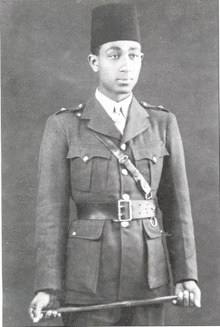
Anwar Sadat was born on 25 December 1918 in Mit Abu El Kom, part of Monufia Governorate in what was then the Sultanate of Egypt, to a poor family, one of 13 brothers and sisters.[10] One of his brothers, Atef Sadat, later became a pilot and was killed in action during the October War of 1973.[11] His father, Anwar Mohammed El Sadat, was an Upper Egyptian, and his mother, Sit Al-Berain, was Sudanese from her father.[12][13]
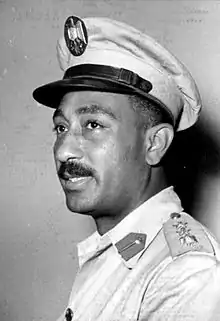
He graduated from the Royal Military Academy in Cairo, the capital of what was then the Kingdom of Egypt, in 1938[14] and was appointed to the Signal Corps. He entered the army as a second lieutenant and was posted to the Anglo-Egyptian Sudan (the Sudan being a condominium under joint British and Egyptian rule at the time). There, he met Gamal Abdel Nasser, and along with several other junior officers they formed the secret Free Officers, an organization committed to expelling the British presence from Egypt and removing royal corruption.[15]
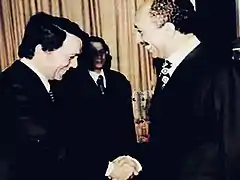
During the Second World War he was imprisoned by the British for his efforts to obtain help from the Axis Powers in expelling the occupying British forces. After the end of the Second World War, at that time, he had met with the secret society that decided to assassinate Amin Osman, Minister of Finance in the Wafd government, and the head of the Egyptian-British Friendship Society, due to his strong sympathy with the British. Osman was assassinated in January 1946. Following the assassination of Amin Osman, Sadat returned again and finally to prison. In Qarmidan prison, he faced the most difficult ordeals of imprisonment by being held in solitary confinement, but the first accused in the Hussein Tawfiq case, escaped, and after there is no criminality evidence all the charges fall and the suspected went free. And the young officer, Salah Zulfikar, at that time was the officer in charge in the prison, and he believed in his heart of Sadat's heroism and that he played a patriotic role towards his country, even though he was imprisoned and his conviction that they were imprisoned because of their love for their country. Zulfikar brought with him food, newspapers and cigarettes for the gentlemen, and helped his family a lot in obtaining visitor permits to check on him. Anwar Sadat was active in many political movements, including the Muslim Brotherhood, the fascist Young Egypt, the pro-palace Iron Guard of Egypt, and the secret military group called the Free Officers.[16] Along with his fellow Free Officers, Sadat participated in the military coup that launched the Egyptian Revolution of 1952, which overthrew King Farouk on 23 July of that year. Sadat was assigned to announce the news of the revolution to the Egyptian people over the radio networks.[17][18][19]
During Nasser's presidency
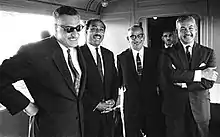
During the presidency of Gamal Abdel Nasser, Sadat was appointed minister of State in 1954. He was also appointed editor of the newly founded daily Al Gomhuria.[20] In 1959, he assumed the position of Secretary to the National Union. Sadat was the President of the National Assembly (1960–1968) and then vice president and member of the presidential council in 1964. He was reappointed as vice president again in December 1969.
Presidency
Some of the major events of Sadat's presidency were his "Corrective Revolution" to consolidate power, the break with Egypt's long-time ally and aid-giver the USSR, the 1973 October War with Israel, the Camp David peace treaty with Israel, the "opening up" (or Infitah) of Egypt's economy, and lastly his assassination in 1981.
Sadat succeeded Nasser as president after the latter's death in October 1970.[21] Sadat's presidency was widely expected to be short-lived.[22] Viewing him as having been little more than a puppet of the former president, Nasser's supporters in government settled on Sadat as someone they could manipulate easily. Sadat surprised everyone with a series of astute political moves by which he was able to retain the presidency and emerge as a leader in his own right.[23] On 15 May 1971,[24] Sadat announced his Corrective Revolution, purging the government, political and security establishments of the most ardent Nasserists. Sadat encouraged the emergence of an Islamist movement, which had been suppressed by Nasser. Believing Islamists to be socially conservative he gave them "considerable cultural and ideological autonomy" in exchange for political support.[25]
In 1971, three years into the War of Attrition in the Suez Canal zone, Sadat endorsed in a letter the peace proposals of UN negotiator Gunnar Jarring, which seemed to lead to a full peace with Israel on the basis of Israel's withdrawal to its pre-war borders. This peace initiative failed as neither Israel nor the United States of America accepted the terms as discussed then.[26]
Corrective Revolution
Shortly after taking office, Sadat shocked many Egyptians by dismissing and imprisoning two of the most powerful figures in the regime, Vice President Ali Sabri, who had close ties with Soviet officials, and Sharawy Gomaa, the Interior Minister, who controlled the secret police.[22] Sadat's rising popularity would accelerate after he cut back the powers of the hated secret police,[22] expelled Soviet military from the country[27] and reformed the Egyptian army for a renewed confrontation with Israel.[22]
Yom Kippur War
On 6 October 1973, in conjunction with Hafez al-Assad of Syria, Sadat launched the October War, also known as the Yom Kippur War (and less commonly as the Ramadan War), a surprise attack against the Israeli forces occupying the Egyptian Sinai Peninsula,[28] and the Syrian Golan Heights in an attempt to retake these respective Egyptian and Syrian territories that had been occupied by Israel since the Six Day War six years earlier. The Egyptian and Syrian performance in the initial stages of the war astonished both Israel, and the Arab World. The most striking achievement (Operation Badr, also known as The Crossing) was the Egyptian military's advance approximately 15 km into the occupied Sinai Peninsula after penetrating and largely destroying the Bar Lev Line. This line was popularly thought to have been an impregnable defensive chain.
As the war progressed, three divisions of the Israeli army led by General Ariel Sharon had crossed the Suez Canal, trying to encircle first the Egyptian Second Army. Although this failed, prompted by an agreement between the United States of America and the Soviet Union, the United Nations Security Council passed Resolution 338 on 22 October 1973, calling for an immediate ceasefire.[29] Although agreed upon, the ceasefire was immediately broken.[30] Alexei Kosygin, the Chairman of the USSR Council of Ministers, cancelled an official meeting with Danish Prime Minister Anker Jørgensen to travel to Egypt where he tried to persuade Sadat to sign a peace treaty. During Kosygin's two-day long stay it is unknown if he and Sadat ever met in person.[31] The Israeli military then continued their drive to encircle the Egyptian army. The encirclement was completed on 24 October, three days after the ceasefire was broken. This development prompted superpower tension, but a second ceasefire was imposed cooperatively on 25 October to end the war. At the conclusion of hostilities, Israeli forces were 40 kilometres (25 mi) from Damascus and 101 kilometres (63 mi) from Cairo.[32]
Peace with Israel
| External audio | |
|---|---|
The initial Egyptian and Syrian victories in the war restored popular morale throughout Egypt and the Arab World and, for many years after, Sadat was known as the "Hero of the Crossing". Israel recognized Egypt as a formidable foe, and Egypt's renewed political significance eventually led to regaining and reopening the Suez Canal through the peace process. His new peace policy led to the conclusion of two agreements on disengagement of forces with the Israeli government. The first of these agreements was signed on 18 January 1974, and the second on 4 September 1975.
One major aspect of Sadat's peace policy was to gain some religious support for his efforts. Already during his visit to the US in October–November 1975, he invited Evangelical pastor Billy Graham for an official visit, which was held a few days after Sadat's visit.[34] In addition to cultivating relations with Evangelical Christians in the US, he also built some cooperation with the Vatican. On 8 April 1976, he visited the Vatican for the first time, and got a message of support from Pope Paul VI regarding achieving peace with Israel, to include a just solution to the Palestinian issue.[35] Sadat, on his part, extended to the Pope a public invitation to visit Cairo.[36]
Sadat also used the media to promote his purposes. In an interview he gave to the Lebanese paper El Hawadeth in early February 1976, he claimed he had secret commitment from the US government to put pressure on the Israeli government for a major withdrawal in Sinai and the Golan Heights.[37] This statement caused some concern to the Israeli government, but Kissinger denied such a promise was ever made.[38]
In January 1977, a series of 'Bread Riots' protested Sadat's economic liberalization and specifically a government decree lifting price controls on basic necessities like bread. The riots lasted for two days and included hundreds of thousands in Cairo. 120 buses and hundreds of buildings were destroyed in Cairo alone.[39] The riots ended with the deployment of the army and the re-institution of the subsidies/price controls.[40][41] During this time, Sadat was also taking a new approach towards improving relations with the West.[22]
The United States and the Soviet Union agreed on 1 October 1977, on principles to govern a Geneva conference on the Middle East.[22] Syria continued to resist such a conference.[22] Not wanting either Syria or the Soviet Union to influence the peace process, Sadat decided to take more progressive stance towards building a comprehensive peace agreement with Israel.[22]
On 19 November 1977, Sadat became the first Arab leader to visit Israel officially when he met with Israeli Prime Minister Menachem Begin, and spoke before the Knesset in Jerusalem about his views on how to achieve a comprehensive peace to the Arab–Israeli conflict, which included the full implementation of UN Resolutions 242 and 338. He said during his visit that he hopes "that we can keep the momentum in Geneva, and may God guide the steps of Premier Begin and Knesset, because there is a great need for hard and drastic decision".[42]
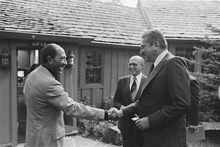
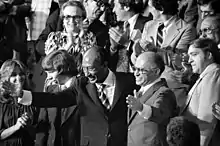
_-_USNWR.jpg.webp)
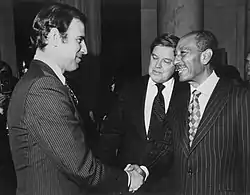
The Peace treaty was finally signed by Anwar Sadat and Israeli Prime Minister Menachem Begin in Washington, D.C., United States, on 26 March 1979, following the Camp David Accords (1978), a series of meetings between Egypt and Israel facilitated by US President Jimmy Carter. Both Sadat and Begin were awarded the Nobel Peace Prize for creating the treaty. In his acceptance speech, Sadat referred to the long-awaited peace desired by both Arabs and Israelis:
Let us put an end to wars, let us reshape life on the solid basis of equity and truth. And it is this call, which reflected the will of the Egyptian people, of the great majority of the Arab and Israeli peoples, and indeed of millions of men, women, and children around the world that you are today honoring. And these hundreds of millions will judge to what extent every responsible leader in the Middle East has responded to the hopes of mankind.[43]
The main features of the agreement were the mutual recognition of each country by the other, the cessation of the state of war that had existed since the 1948 Arab–Israeli War, and the complete withdrawal by Israel of its armed forces and civilians from the rest of the Sinai Peninsula, which Israel had captured during the 1967 Six-Day War.
The agreement also provided for the free passage of Israeli ships through the Suez Canal and recognition of the Strait of Tiran and the Gulf of Aqaba as international waterways. The agreement notably made Egypt the first Arab country to officially recognize Israel. The peace agreement between Egypt and Israel has remained in effect since the treaty was signed.
The treaty was extremely unpopular in most of the Arab World and the wider Muslim World.[44] His predecessor Nasser had made Egypt an icon of Arab nationalism, an ideology that appeared to be sidelined by an Egyptian orientation following the 1973 war (see Egypt). The neighboring Arab countries believed that in signing the accords, Sadat had put Egypt's interests ahead of Arab unity, betraying Nasser's pan-Arabism, and destroyed the vision of a united "Arab front" for the support of the Palestinians against the "Zionist Entity". However, Sadat decided early on that peace was the solution.[22][45] Sadat's shift towards a strategic relationship with the US was also seen as a betrayal by many Arabs. In the United States his peace moves gained him popularity among some Evangelical circles. He was awarded the Prince of Peace Award by Pat Robertson.[46]
In 1979, the Arab League suspended Egypt in the wake of the Egyptian–Israel peace agreement, and the League moved its headquarters from Cairo to Tunis. Arab League member states believed in the elimination of the "Zionist Entity" and Israel at that time. It was not until 1989 that the League re-admitted Egypt as a member, and returned its headquarters to Cairo. As part of the peace deal, Israel withdrew from the Sinai Peninsula in phases, completing its withdrawal from the entire territory except the town of Taba by 25 April 1982 (withdrawal from which did not occur until 1989).[22] The improved relations Egypt gained with the West through the Camp David Accords soon gave the country resilient economic growth.[22] By 1980, however, Egypt's strained relations with the Arab World would result in a period of rapid inflation.[22]
Relationship with Mohammad Reza Shah Pahlavi of Iran
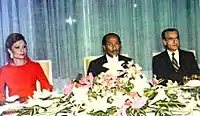
The relationship between Iran and Egypt had fallen into open hostility during Gamal Abdel Nasser's presidency. Following his death in 1970, President Sadat turned this around quickly into an open and close friendship.[47]
In 1971, Sadat addressed the Iranian parliament in Tehran in fluent Persian, describing the 2,500-year-old historic connection between the two lands.[47]
Overnight, the Egyptian and Iranian governments were turned from bitter enemies into fast friends. The relationship between Cairo and Tehran became so friendly that the Shah of Iran, Mohammad Reza Pahlavi, called Sadat his "dear brother".[47]
After the 1973 war with Israel, Iran assumed a leading role in cleaning up and reactivating the blocked Suez Canal with heavy investment. The country also facilitated the withdrawal of Israel from the occupied Sinai Peninsula by promising to substitute the loss of the oil to the Israelis with free Iranian oil if they withdrew from the Egyptian oil wells in western Sinai.[47]
All these added more to the personal friendship between Sadat and the Shah of Iran. (The Shah's first wife was Princess Fawzia of Egypt. She was the eldest daughter of Sultan Fuad I of Egypt and Sudan (later King Fuad I) and his second wife Nazli Sabri.)[47]
After his overthrow, the deposed Shah spent the last months of his life in exile in Egypt. When the Shah died, Sadat ordered that he be given a state funeral and be interred at the Al-Rifa'i Mosque in Cairo, the resting place of Egyptian Khedive Isma'il Pasha, his mother Khushyar Hanim, and numerous other members of the royal family of Egypt and Sudan.[48]
Assassination
The last months of Sadat's presidency were marked by internal uprising.[22] Sadat dismissed allegations that the rioting was incited by domestic issues, believing that the Soviet Union was recruiting its regional allies in Libya and Syria to incite an uprising that would eventually force him out of power.[22] Following a failed military coup in June 1981, Sadat ordered a major crackdown that resulted in the arrest of numerous opposition figures.[22] Although Sadat still maintained high levels of popularity in Egypt,[22] it has been said that he was assassinated "at the peak" of his unpopularity.[49]
Earlier in his presidency, Islamists had benefited from the 'rectification revolution' and the release from prison of activists jailed under Nasser.[24] But Sadat's Sinai treaty with Israel enraged Islamists, particularly the radical Egyptian Islamic Jihad. According to interviews and information gathered by journalist Lawrence Wright, the group was recruiting military officers and accumulating weapons, waiting for the right moment to launch "a complete overthrow of the existing order" in Egypt. Chief strategist of El-Jihad was Abbud al-Zumar, a colonel in the military intelligence whose "plan was to kill the main leaders of the country, capture the headquarters of the army and State Security, the telephone exchange building, and of course the radio and television building, where news of the Islamic revolution would then be broadcast, unleashing—he expected—a popular uprising against secular authority all over the country".[50]
In February 1981, Egyptian authorities were alerted to El-Jihad's plan by the arrest of an operative carrying crucial information. In September, Sadat ordered a highly unpopular roundup of more than 1,500 people, including many Jihad members, but also the Coptic Pope and other Coptic clergy, intellectuals and activists of all ideological stripes.[51] All non-government press was banned as well.[52] The round up missed a Jihad cell in the military led by Lieutenant Khalid Islambouli, who would succeed in assassinating Anwar Sadat that October.[53]
According to Tala'at Qasim, ex-head of the Gama'a Islamiyya interviewed in Middle East Report, it was not Islamic Jihad but his organization, known in English as the "Islamic Group", that organized the assassination and recruited the assassin (Islambouli). Members of the Group's 'Majlis el-Shura' ('Consultative Council') – headed by the famed 'blind shaykh' – were arrested two weeks before the killing, but they did not disclose the existing plans and Islambouli succeeded in assassinating Sadat.[54]
On 6 October 1981, Sadat was assassinated during the annual victory parade held in Cairo to celebrate Egypt's crossing of the Suez Canal.[55] Islambouli emptied his assault rifle into Sadat's body while in the front of the grandstand, mortally wounding the President. In addition to Sadat, eleven others were killed, including the Cuban ambassador, an Omani general, a Coptic Orthodox bishop and Samir Helmy, the head of Egypt's Central Auditing Agency (CAA).[56][57] Twenty-eight were wounded, including Vice President Hosni Mubarak, Irish Defence Minister James Tully, and four US military liaison officers.
The assassination squad was led by Lieutenant Khalid Islambouli after a fatwā approving the assassination had been obtained from Omar Abdel-Rahman.[58] Islambouli was tried, found guilty, sentenced to death, and executed by firing squad in April 1982.
Aftermath
Sadat was succeeded by his vice president Hosni Mubarak, whose hand was injured during the attack. Sadat's funeral was attended by a record number of dignitaries from around the world, including a rare simultaneous attendance by three former US presidents: Gerald Ford, Jimmy Carter and Richard Nixon. Sudan's President Gaafar Nimeiry was the only Arab head of state to attend the funeral. Only 3 of 24 states in the Arab League—Oman, Somalia and Sudan—sent representatives at all.[59] Israel's prime minister, Menachem Begin, considered Sadat a personal friend and insisted on attending the funeral, walking throughout the funeral procession so as not to desecrate the Sabbath.[60] Sadat was buried in the unknown soldier memorial in Cairo, across the street from the stand where he was assassinated.
Over three hundred Islamic radicals were indicted in the trial of assassin Khalid Islambouli, including future al-Qaeda leader Ayman al-Zawahiri, Omar Abdel-Rahman, and Abd al-Hamid Kishk. The trial was covered by the international press and Zawahiri's knowledge of English made him the de facto spokesman for the defendants. Zawahiri was released from prison in 1984. Abboud al-Zomor and Tareq al-Zomor, two Islamic Jihad leaders imprisoned in connection with the assassination, were released on 11 March 2011.[61]
Despite these facts, the nephew of the late president, Talaat Sadat, claimed that the assassination was an international conspiracy. On 31 October 2006, he was sentenced to a year in prison for defaming Egypt's armed forces, less than a month after he gave the interview accusing Egyptian generals of masterminding his uncle's assassination. In an interview with a Saudi television channel, he also claimed both the United States and Israel were involved: "No one from the special personal protection group of the late president fired a single shot during the killing, and not one of them has been put on trial," he said.[62]
Media portrayals of Anwar Sadat

In 1983, Sadat, a miniseries based on the life of Anwar Sadat, aired on US television with Oscar-winning actor Louis Gossett, Jr. in the title role. The film was promptly banned by the Egyptian government, as were all other movies produced and distributed by Columbia Pictures, over allegations of historical inaccuracies. A civil lawsuit was brought by Egypt's artists' and film unions against Columbia Pictures and the film's directors, producers and scriptwriters before a court in Cairo, but was dismissed, since the alleged slanders, having taken place outside the country, fell outside the Egyptian courts' jurisdiction.[63]
The film was critically acclaimed in North America, but was unpopular among Egyptians and in the Egyptian press. Western authors attributed the film's poor reception in Egypt to racism – Gossett being African-American – in the Egyptian government or Egypt in general.[64] Either way, one Western source wrote that Sadat's portrayal by Gossett "bothered race-conscious Egyptians and wouldn't have pleased [the deceased] Sadat," who identified as Egyptian and Northeast African, not black.[65] The two-part series earned Gossett an Emmy nomination in the United States.
He was portrayed by Robert Loggia in the 1982 television movie A Woman Called Golda, opposite Ingrid Bergman as Golda Meir.
The first Egyptian depiction of Sadat's life came in 2001, when Ayyam El Sadat (English: Days of Sadat) was released in Egyptian cinemas. This movie, by contrast, was a major success in Egypt, and was hailed as Ahmed Zaki's greatest performance to date.[66]
The young Sadat is a major character in Ken Follett's thriller The Key to Rebecca, taking place in World War II Cairo. Sadat, at the time a young officer in the Egyptian Army and involved in anti-British revolutionary activities, is presented quite sympathetically; his willingness to cooperate with German spies is clearly shown to derive from his wish to find allies against British occupation of his country, rather than from support of Nazi ideology. Some of the scenes in the book, such as Sadat's arrest by the British, closely follow the information provided in Sadat's own autobiography.
Sadat was a recurring character on Saturday Night Live, played by Garrett Morris, who bore a resemblance to Sadat.
Honours awarded
National
- Egypt:
 Collar of the Order of the Republic
Collar of the Order of the Republic Grand Cordon of the Order of the Nile
Grand Cordon of the Order of the Nile Grand Cross of the Order of Merit
Grand Cross of the Order of Merit Supreme Class of the Order of the Virtues
Supreme Class of the Order of the Virtues
Foreign
- Albania:
_-_Grand_Cross_BAR.png.webp) Grand Cross of the Order of Fidelity
Grand Cross of the Order of Fidelity
- Austria:
 Grand Star of the Order of Honour for Services to the Republic of Austria
Grand Star of the Order of Honour for Services to the Republic of Austria
- Italy:
 Knight Grand Cross of the Order of Merit of the Italian Republic
Knight Grand Cross of the Order of Merit of the Italian Republic
- Kuwait:
_-_ribbon_bar.gif) Collar of the Order of Mubarak the Great
Collar of the Order of Mubarak the Great
- Malaysia:
_-_SMN.svg.png.webp) Honorary Grand Commander of the Order of the Defender of the Realm (SMN (K)) – Tun (1965)[67]
Honorary Grand Commander of the Order of the Defender of the Realm (SMN (K)) – Tun (1965)[67]
- Nepal:
 Member First Class of the Order of the Star of Nepal
Member First Class of the Order of the Star of Nepal Member of the Order of the Benevolent Ruler
Member of the Order of the Benevolent Ruler
 Saudi Arabia:
Saudi Arabia:
 Recipient of the Order of King Abdulaziz, 1st class
Recipient of the Order of King Abdulaziz, 1st class
- Syria:
_-_ribbon_bar.gif) Member First Class of the Order of the Umayyads
Member First Class of the Order of the Umayyads
- Tunisia:
_-_ribbon_bar.gif) Recipient of the Order of the Republic
Recipient of the Order of the Republic
- United States:
.svg.png.webp) Recipient of the Presidential Medal of Freedom (1984)
Recipient of the Presidential Medal of Freedom (1984) Recipient of the Congressional Gold Medal (2018, posthumous)[68]
Recipient of the Congressional Gold Medal (2018, posthumous)[68]
Bibliography
- Sadat, Anwar (1954). قصة الثورة كاملة (The Full Story of the Revolution) (in Arabic). Cairo: Dar el-Hilal. OCLC 23485697.
- Sadat, Anwar (1955). صفحات مجهولة (Unknown Pages of the Revolution) (in Arabic). Cairo: دار التحرير للطبع والنشر،. OCLC 10739895.
- Sadat, Anwar (1957). Revolt on the Nile. New York: J. Day Co. OCLC 1226176.
- Sadat, Anwar (1958). Son, This Is Your Uncle Gamal – Memoirs of Anwar el-Sadat. Beirut: Maktabat al-ʻIrfān. OCLC 27919901.
- Sadat, Anwar (1978). In Search of Identity: An Autobiography. New York: Harper & Row. ISBN 0-06-013742-8.
Notes
See also
- History of Egypt under Anwar Sadat
References
- Finklestone, Joseph (2013), Anwar Sadat: Visionary Who Dared, Routledge, ISBN 978-1135195656,
Significantly, Anwar Sadat did not mention aspects in his early life...It was in Mit Abul-Kum that Eqbal Afifi, the woman who was his wife for ten years and whom he left, was also born. Her family was of higher social standing than Anwar's, being of Turkish origin...
- "Sadat". Collins English Dictionary. HarperCollins. Retrieved 8 May 2019.
- "Sadat" (US) and "Sadat". Oxford Dictionaries UK English Dictionary. Oxford University Press.
- "Sādāt". Merriam-Webster Dictionary. Retrieved 8 May 2019.
- "Peace with Israel".
- Graham, Nick (21 August 2010). "Middle East Peace Talks: Israel, Palestinian Negotiations More Hopeless Than Ever". HuffPost. Retrieved 2 February 2011.
- Vatikiotis, P. J. (1992). The History of Modern Egypt (4th edition ed.). Baltimore: Johns Hopkins University. p. 443.
- "The Failure at Camp David – Part III Possibilities and pitfalls for further negotiations". Textus. Retrieved 2 February 2011.
- "Egypt and Israel Sign Formal Treaty, Ending a State of War After 30 Years; Sadat and Begin Praise Carter's Role". The New York Times.
- "Profile: Anwar Sadat The former Egyptian president believed a peace deal with Israel was vital to end wars". Al Jazeera. 25 January 2010. Retrieved 14 May 2013.
- "Sadat's Brother Reported Killed During October War". The New York Times. 6 January 1974. Retrieved 10 November 2020.
- C. J. De Wet (2006). Development-induced Displacement: Problems, Policies, and People. Berghahn Books. p. 198. ISBN 978-1-84545-095-3. Retrieved 31 January 2013.
- "Sadat's Wife autobiography".
- Alagna, Magdalena (2004). Anwar Sadat. The Rosen Publishing Group. ISBN 9780823944644.
- Wagner, Heather Lehr (2007). Anwar Sadat and Menachem Begin: Negotiating Peace in the Middle East. Infobase Publishing. ISBN 9781438104409.
- Jon B. Alterman (April 1998). "Sadat and His Legacy: Egypt and the World, 1977–1997". The Washington Institute.
- "إبنة صلاح ذو الفقار تكشف عن دور والدها أثناء اعتقال السادات". مصراوي.كوم. Retrieved 7 February 2022.
- "رقية السادات لـ"اليوم السابع": صلاح ذو الفقار كان المشرف على زنزانة والدى .. عندما ذهبت مع والدتى لزيارة أبى فى المعتقل وجدت صوت تعذيب فطمأننى الفنان الراحل: والدك لا يتم تعذيبه". اليوم السابع. 25 December 2019. Retrieved 7 February 2022.
- "دفعة وزراء الداخلية وحارس سجن السادات.. ما لا تعرفه عن صلاح ذو الفقار". اليوم السابع. 22 December 2020. Retrieved 7 February 2022.
- Alterman, Jon B. (1998). "New Media New Politics?" (PDF). 48. The Washington Institute. Archived from the original (PDF) on 13 May 2013. Retrieved 7 April 2013.
{{cite journal}}: Cite journal requires|journal=(help) - "Big 'yes' for Anwar Sadat". Ottawa Citizen. Cairo. Associated Press. 16 October 1970. Retrieved 22 December 2012.
- "Anwar el-Sadat, the Daring Arab Pioneer of Peace with Israel". The New York Times.
- "Egypt Corrective Revolution 1971". Onwar. 16 December 2000. Archived from the original on 1 February 2011. Retrieved 2 February 2011.
- Le prophète et Pharaon by Kepel, p. 74
- Gilles Kepel, Jihad: The Trail of Political Islam, p. 83
- Chomsky, Noam (2003). Understanding Power. pp. 127–128.
I wrote [Newsweek] a letter, the kind of letter you write to Newsweek–you know, four lines–in which I said, '[George] Will has one statement of fact, it's false; Sadat made a peace offer in 1971, and Israel and the United States turned it down.' Well, a couple days later I got a call from a research editor who checks facts for the Newsweek 'Letters' column. She said: 'We're kind of interested in your letter; where did you get those facts?' So I told her, 'Well, they're published in Newsweek, on 8 February 1971'
- Hughes, Geraint (5 April 2020). "Courting Sadat: The Heath Government and Britain's Arms Sales to Egypt, 1970–1973". The International History Review. 43 (2): 317–332. doi:10.1080/07075332.2020.1745256. ISSN 0707-5332. S2CID 216279788.
- "The Egyptian Military's Huge Historical Role". 5 July 2013. Retrieved 20 November 2017.
- Mary Ann Fay (December 1990). "A Country Study". The Library of Congress. pp. Chapter 1, Egypt: The Aftermath of War: October 1973 War. Retrieved 13 February 2008.
- "Situation report in the Middle East" (PDF). Department of State. Retrieved 22 December 2012.
- Golan, Galia (1990). Soviet Policies in the Middle East: From World War Two to Gorbachev. Cambridge University Press Archive. p. 89. ISBN 978-0521358590.
- Morris, Benny (2001). Righteous Victims: A History of the Zionist-Arab Conflict, 1881–1998. New York: 1999. ISBN 9780679421207. Retrieved 6 October 2017.
- "National Press Club Luncheon Speakers, Anwar Sadat, February 6, 1978". National Press Club via Library of Congress. Retrieved 21 October 2016.
- "Text of diplomatic cable regarding Graham's visit to Egypt (US government website)". Retrieved 2 February 2011.
- "Text of Pope's message to Sadat". Vatican. 1976. Retrieved 2 February 2011.
- "John Anthony Volpe (US Ambassador to Italy), cable describing Sadat's visit to the Vatican". Retrieved 2 February 2011.
- "Sadat interview to El Hawadeth" (PDF). Archived from the original (PDF) on 12 January 2011. Retrieved 2 February 2011.
- "Telephone conversation between Kissinger and Rabin, February 5, 1976" (PDF). Retrieved 2 February 2011.
- Mary Ann Weaver, Portrait of Egypt, p. 25
- Olivier, Roy (1994). Failure of Political Islam. Cambridge: Harvard University Press. p. 56. ISBN 0-674-29140-9.
- Weaver, Mary Ann (1999). Portrait of Egypt. New York: Farrar, Straus and Giroux. p. 25. ISBN 0-374-23542-2.
- "Sadat Visits Israel: 1977 Year in Review". United Press International. Archived from the original on 19 January 2011. Retrieved 2 February 2011.
- "Anwar Al-Sadat". Archived from the original on 9 February 2009. Retrieved 22 January 2009.
- Vatikiotis, P.J. (1992). The History of Modern Egypt (Fourth ed.). Baltimore: Johns Hopkins University. p. 443. ISBN 0-8018-4214-X.
- "The Nobel Peace Prize 1978 – Presentation Speech". Nobel prize. 1978. Retrieved 2 February 2011.
- "Teaching". Pat Robertson. Archived from the original on 21 December 2010. Retrieved 2 February 2011.
- Zephyr, Alexander (13 November 2014). Psalm 83: A New Discovery. ISBN 9781491750742.
- An Ideology of Martyrdom – Time
- Le prophète et Pharaon by Kepel, p. 192
- Wright, 2006, p. 49
- 'Cracking Down', Time, 14 September 1981
- Le prophète et Pharaon by Kepel, pp. 103–4
- Wright, 2006, p. 50
- For an account that uses this version of events, look at Middle East Report's January–March 1996 issue, specifically Hisham Mubarak's interview with ? On pages 42–43 Qasim deals specifically with rumors of Jihad Group involvement in the assassination, and denies them entirely.
- "1981 Year in Review". United Press International. 1981. Retrieved 22 December 2012.
- "Taher Helmi: Feats of circumstance". Al Ahram Weekly. 23 March 2005. Archived from the original on 23 February 2013. Retrieved 23 February 2013.
{{cite news}}: CS1 maint: bot: original URL status unknown (link) - "Taher Helmy's Speech at the AUC Commencement Ceremony 2008". Archived from the original on 30 October 2021. Retrieved 22 December 2012 – via YouTube.
- J. Tyler Dickovick (9 August 2012). Africa 2012. Stryker Post. pp. 41–. ISBN 978-1-61048-882-2. Retrieved 22 December 2012.
- Tuhoy, William (11 October 1981). Most of Arab world ignores Sadat funeral. The Spokesman-Review.
- Avner, Yehuda (24 July 2010). The Prime Ministers (p. 575). The Toby Press, LLC. Kindle Edition.
- Egypt Releases Brother of Al Qaeda's No. 2, Liam Stack, The New York Times, 17 March 2011
- Sadat nephew in court appearance. BBC News. 18 October 2006.
- Reuters (1984). Suit Over Film 'Sadat' Is Dismissed in Cairo The New York Times Retrieved 7 January 2009.
- Benjamin P. Bowser, Racism and Anti-Racism in World Perspective (Sage Series on Race and Ethnic Relations, Volume 13), (Sage Publications, Inc: 1995), p. 108
Upset by 'Sadat,' Egypt Bars Columbia Films - Walter M. Ulloth, Dana Brasch, The Press and the State: Sociohistorical and Contemporary Studies, (University Press of America: 1987), p. 483
- Adel Darwish (31 March 2005). "Ahmed Zaki: 'Black Tiger' of Egyptian film". The Middle East Internet News Network. Retrieved 13 February 2008.
- "Senarai Penuh Penerima Darjah Kebesaran, Bintang dan Pingat Persekutuan Tahun 1965" (PDF). Archived from the original (PDF) on 28 September 2018. Retrieved 15 June 2016.
- "Trump signs law honoring Anwar Sadat". 14 December 2018.
Further reading
- Avner, Yehuda (2010). The Prime Ministers: An Intimate Narrative of Israeli Leadership. The Toby Press. ISBN 978-1-59264-278-6.
- Berenji, Shahin. "Sadat and the Road to Jerusalem: Bold Gestures and Risk Acceptance in the Search for Peace." International Security 45.1 (2020): 127–163.
- Eidelberg, Paul (1979). Sadat's Strategy. Dollard des Ormeaux: Dawn Books. ISBN 0-9690001-0-3.
- Finklestone, Joseph. Anwar Sadat: visionary who dared (Routledge, 2013). biography.
- Haykal, Muhammad Hasanayn (1982). Autumn of Fury: The Assassination of Sadat. Wm Collins & Sons & Co. ISBN 0-394-53136-1.
- Hurwitz, Harry; Medad, Yisrael (2010). Peace in the Making. Gefen Publishing House. ISBN 978-965-229-456-2.
- Israeli, Raphael. "Sadat: The Calculus of War and Peace." The Diplomats, 1939-1979 (Princeton University Press, 2019) pp. 436–458. online
- Meital, Yoram (1997). Egypt's Struggle for Peace: Continuity and Change, 1967–1971. Gainesville: University Press of Florida. ISBN 0-8130-1533-2.
- Waterbury, John (1983). The Egypt of Nasser and Sadat: The Political Economy of Two Regimes (Limited ed.). Princeton University Press. ISBN 0-691-07650-2.
- Wright, Lawrence (2006). The Looming Tower: Al-Qaeda and the Road to 9/11. New York: Knopf. ISBN 0-375-41486-X.
External links
- Bibliotheca Alexandrina, Front Page
- Ben-Gurion on Anwar Sadat Wanting Peace, 1971 Shapell Manuscript Foundation
- Anwar Sadat Chair for Peace and Development at the University of Maryland
- Remarks at the Presentation Ceremony for the Presidential Medal of Freedom – March 26, 1984 Archived 18 September 2012 at the Wayback Machine
- Anwar Sadat at IMDb
- Anwar Sadat collected news and commentary at The New York Times
- Works by or about Anwar Sadat in libraries (WorldCat catalog)
- Free Egyptians Point of View About Sadat's Assassination (in Arabic and English) (Internet Archive)
- The short film Anwar Sadat (1976) is available for free download at the Internet Archive.
- Anwar Sadat at Find a Grave
- Sadat Movie (Produced in 1983) – Banned from the Middle East because of some historical mistakes.
- Anwar al-Sadat on Nobelprize.org